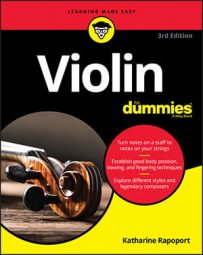Imagine you are a bird and the upper parts of your arms are wings. Go on, give a little flap, or do your best imitation of a chicken dance! What does a bird impersonation have to do with playing the violin? Well, when you cross over to another string with your bow, your upper arm changes levels, just like a bird flapping its wings.
To work on your arm-level skills, first set up your violin and bow in playing position and then land the middle of the bow on the E string. As you roll the bow to and fro across the strings, you feel a gentle wave that travels all the way from the tip of the bow, through the bow to the frog, and then along your whole arm to your shoulder — almost as though you’re rolling a table tennis ball back and forth along the top of your bow stick, without letting it fall off at either end.
To keep that imaginary ball moving, your right arm waves up and down, too. Keep your wrist a bit loose so that it floats lightly up and down with the movement. Observe the bow’s path carefully, making sure the stick moves more or less parallel to the violin’s bridge.
When you have a sense of the scope of the rolling movement, the next step is to go more steadily so that you can feel the specific level of each string.
Two neighboring strings
To cross between two neighboring strings, first, try rolling the bow silently from the E string to the A string and then back again to E, letting your arm’s level float up and down with the general level of the bow. The movement is not big, but keeping the same relation between bow and string at each level helps the bow sound equally good on each string — and keeping your bow arm moving freely is what you’re about here!
After you can roll from E to A and back, try the same rolling motion between different pairs of strings. Starting with the bow on the A string, roll back and forth between A and D levels, letting your arm’s level float up and down with the bow. Then try rolling the bow between the D and G strings.
Playing the violin requires your arm to float to a higher level to play a lower-sounding string. Now, how weird is that?
Two non-neighboring strings
You can expand the bow-rolling motion so that your bow crosses over to strings that are not next door to each other.
Land your bow on the E string again, and then roll silently over to the D string. Simply roll over the A string without lifting the bow at all, and then stop the movement when your bow reaches the D string. Rolling back to the E string involves exactly the same process, just as if you’re putting the bow into reverse. The whole movement has a slightly greater arc than it does when you roll to a neighboring string.
When crossing with your bow to a non-neighboring string, keep your focus on the place where the bow contacts the string, letting your arm’s level float up and down as needed. Depending on the curvature of the bridge and the length of your arm, the level of your elbow will change by up to about 6 inches, by the time you change strings between E and G.
Stand in front of a mirror to watch the point of your elbow doing this rolling movement, so that you have a sense of what it looks like.
Use the same rolling motion for the next pair of strings. Set your bow on the A string to start. After you’re balanced well on the A string, roll over to the G string, passing silently over the D string as you go. This action is the same as crossing from the E string to the D string, but if you watch your elbow’s level in the mirror, you’ll see that it begins and ends at slightly higher levels than when you use the E and D strings.
Now, for the biggest (and most fun!) string crossing: E string to G string. After setting your bow on the E string, roll the bow all the way over A and D until it comes to rest on the G string. That’s quite a big arc! Going back and forth between the E string and the G string will let your arm feel the full range of bowing levels.
Avoid rolling so far with the bow that the horsehair touches the edge of the violin when you cross over between your E and G strings. All you need to do is to go as far as you need to just touch the E string or the G string — in this case, more is not better!
Seven wonderful levels
The violin has four strings, so placing the bow on each individual string involves finding one of four possible arm levels.
Additionally, because you can place the bow on two strings at the same time — when the bow is resting on E and A, A and D, or D and G — three “in-between” bow levels exist. So in fact, you need to know seven levels.
Go on, try it out! Just resting the bow silently on each level gives you an idea of how it feels to have your arm adjust to the seven different levels. When you have a sense of where the levels are, try bowing on the open strings.

